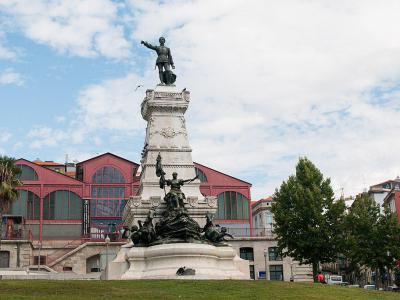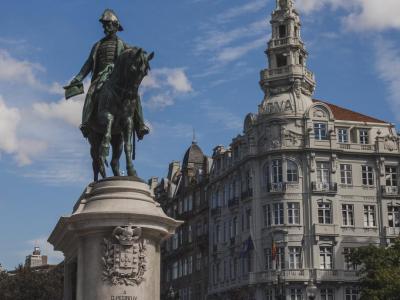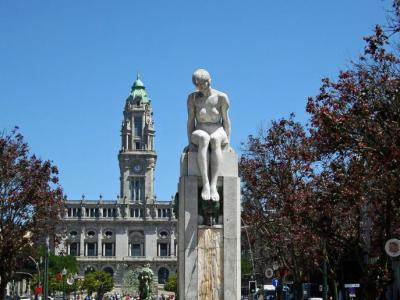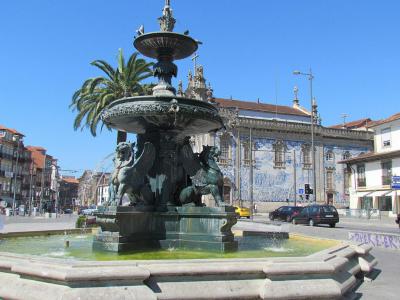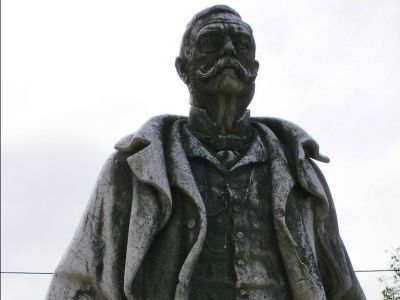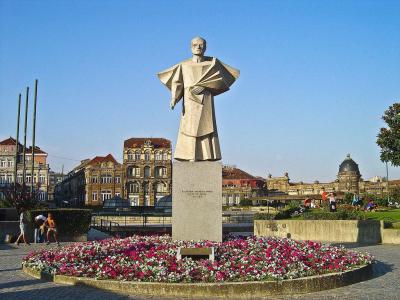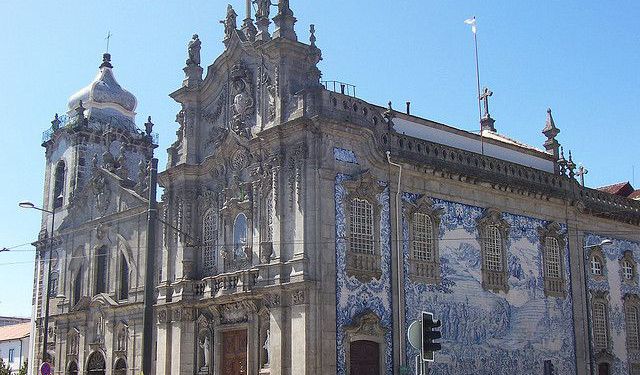
Porto's Monuments and Statues (Self Guided), Porto
In general, just like any other European nation, sunny Portugal is rich in history and matching love of monuments. This is more so evident in the country's second largest city of Porto, dotted with statues and sculptures of various sort, decorating the gardens, sidewalks, squares and various corners. Each of them has its own story; some are quite old, while others are not so much and rather funny – ideal for a photo shoot!
Today the municipal authorities work hard to preserve these monuments and statues, acquired over a long period of time, to make them look like they did when they first appeared. Included in this guide are some of the sculptural landmarks worthy of being discovered and, perhaps, taking some pictures of.
Statue of Prince Henry the Navigator – celebrates the life of the 14th-century prince, famous for his maritime expeditions and military exploits; installed in 1894.
Estátua de Vímara Peres – the equestrian statue of the mythical ninth-century nobleman from Galicia; opened in 1968.
The Newspaper Vendor Statue – a bronze tribute to ardina, the newspaper seller; one of the most photographed statues in the city; unveiled in 1990.
Estátua Equestre de D. Pedro IV – an 1866 monument dedicated to King Peter IV.
Fountain of Youth Naked Girl – a 1929 sculpture by Henrique Moreira.
"Thirteen Laughing at Each Other" – a set of sculptures in Jardim de João Chagas, designed by Juan Muñoz in 2001.
To see these and other beautiful creations adorning the streets of Porto in more detail, take this self-guided walk.
Today the municipal authorities work hard to preserve these monuments and statues, acquired over a long period of time, to make them look like they did when they first appeared. Included in this guide are some of the sculptural landmarks worthy of being discovered and, perhaps, taking some pictures of.
Statue of Prince Henry the Navigator – celebrates the life of the 14th-century prince, famous for his maritime expeditions and military exploits; installed in 1894.
Estátua de Vímara Peres – the equestrian statue of the mythical ninth-century nobleman from Galicia; opened in 1968.
The Newspaper Vendor Statue – a bronze tribute to ardina, the newspaper seller; one of the most photographed statues in the city; unveiled in 1990.
Estátua Equestre de D. Pedro IV – an 1866 monument dedicated to King Peter IV.
Fountain of Youth Naked Girl – a 1929 sculpture by Henrique Moreira.
"Thirteen Laughing at Each Other" – a set of sculptures in Jardim de João Chagas, designed by Juan Muñoz in 2001.
To see these and other beautiful creations adorning the streets of Porto in more detail, take this self-guided walk.
How it works: Download the app "GPSmyCity: Walks in 1K+ Cities" from Apple App Store or Google Play Store to your mobile phone or tablet. The app turns your mobile device into a personal tour guide and its built-in GPS navigation functions guide you from one tour stop to next. The app works offline, so no data plan is needed when traveling abroad.
Porto's Monuments and Statues Map
Guide Name: Porto's Monuments and Statues
Guide Location: Portugal » Porto (See other walking tours in Porto)
Guide Type: Self-guided Walking Tour (Sightseeing)
# of Attractions: 9
Tour Duration: 1 Hour(s)
Travel Distance: 2.1 Km or 1.3 Miles
Author: ChristineS
Sight(s) Featured in This Guide:
Guide Location: Portugal » Porto (See other walking tours in Porto)
Guide Type: Self-guided Walking Tour (Sightseeing)
# of Attractions: 9
Tour Duration: 1 Hour(s)
Travel Distance: 2.1 Km or 1.3 Miles
Author: ChristineS
Sight(s) Featured in This Guide:
- Statue of Prince Henry the Navigator
- Estátua de Vímara Peres (Vímara Peres Statue)
- Newspaper Vendor Statue
- Estátua Equestre de D. Pedro IV (King Peter IV Monument)
- Fountain of Youth/Naked Girl
- Fonte dos Leões (Lions Fountain)
- Estatua de Ramalho Ortigão (Ramalho Ortigão Statue)
- António Ferreira Gomes Statue
- "Thirteen Laughing at Each Other" Statue
1) Statue of Prince Henry the Navigator
The statue of Prince Henry the Navigator, was first installed in Porto in 1894. The creation of sculptor Tomás Costa, it celebrates the life of this 14th century prince who is famous for his many maritime discoveries. The prince was the fifth son of King John I who was the founder of the Dynasty of Avis.
Born in 1394, Prince Henry was a master seaman whose expeditions and military exploits are famous. He was credited with securing significant trade routes for Portugal, making the country the world's major economic power of the time. It was under the leadership of Prince Henry that Portugal sent expeditions around the Ivory Coast of Africa, which gave Portugal access to the vast riches of Africa, including gold. He was rewarded for his discoveries with many titles, including appointment as the leader of the Order of Christ.
The monument is located near the Ribeira section of Porto. It has a very tall pedestal with the sculpture of the Prince who is turned toward the ocean and points authoritatively, as if giving orders to his men. The pedestal has relief sculptures encrusted thereupon, depicting scenes from the life of Prince Henry.
Born in 1394, Prince Henry was a master seaman whose expeditions and military exploits are famous. He was credited with securing significant trade routes for Portugal, making the country the world's major economic power of the time. It was under the leadership of Prince Henry that Portugal sent expeditions around the Ivory Coast of Africa, which gave Portugal access to the vast riches of Africa, including gold. He was rewarded for his discoveries with many titles, including appointment as the leader of the Order of Christ.
The monument is located near the Ribeira section of Porto. It has a very tall pedestal with the sculpture of the Prince who is turned toward the ocean and points authoritatively, as if giving orders to his men. The pedestal has relief sculptures encrusted thereupon, depicting scenes from the life of Prince Henry.
Sight description based on Wikipedia.
2) Estátua de Vímara Peres (Vímara Peres Statue)
Vímara Peres was a ninth-century nobleman from the Kingdom of Galicia. Vímara was a vassal of the King of Asturias, Alfonso III, and was sent to reconquer and secure from the Moors (Arabs and Berbers who had invaded Visigothic Hispania), in the west coastal fringe of Gallaecia, the area from the Minho River to the Douro River, including the city of Portus Cale, later Porto and Gaia, from where the name of Portugal emerged.
He was able to expel the Moors and founded a fortified town under his own name Vimaranis (of Vimar) which later became Guimaranis, present day Guimarães (the Portuguese call it "The Cradle City"). Vímara Peres died in 873 in the territory of A Coruña.
Opened in 1968, this equestrian statue in bronze, made by the sculptor Barata Feyo, represents the mythical nobleman Vímara Peres.
He was able to expel the Moors and founded a fortified town under his own name Vimaranis (of Vimar) which later became Guimaranis, present day Guimarães (the Portuguese call it "The Cradle City"). Vímara Peres died in 873 in the territory of A Coruña.
Opened in 1968, this equestrian statue in bronze, made by the sculptor Barata Feyo, represents the mythical nobleman Vímara Peres.
Sight description based on Wikipedia.
3) Newspaper Vendor Statue
The mass epidemic of monumental homage to plumbers, janitors, and other professions, that has hit Europe in recent decades, has affected Porto all the same. Found just around the corner from the railway station, this cute little statue is very easy to miss, especially if you don't know where to look. Still, it is well worth looking at or even snapping a photo of, given that this is one of the most photographed statues in Porto, much loved by tourists.
Called the Estátua do Ardina (Newspaper Vendor Statue), this life-size, bronze sculpture pays tribute to an “ardina”, the street seller of newspapers. Created by Manuel Dias in 1990, the statue depicts the ardina at work, with a newspaper in hand, bag over his shoulder, leaning against a traditional post box – reminder of the times when the news was spread this way, and this way only.
Now that the Internet is slowly killing off paper press, this bronze newspaper vendor in Liberdade Square may be the last representative of his trade still around. So, hurry up!
Called the Estátua do Ardina (Newspaper Vendor Statue), this life-size, bronze sculpture pays tribute to an “ardina”, the street seller of newspapers. Created by Manuel Dias in 1990, the statue depicts the ardina at work, with a newspaper in hand, bag over his shoulder, leaning against a traditional post box – reminder of the times when the news was spread this way, and this way only.
Now that the Internet is slowly killing off paper press, this bronze newspaper vendor in Liberdade Square may be the last representative of his trade still around. So, hurry up!
Sight description based on Wikipedia.
4) Estátua Equestre de D. Pedro IV (King Peter IV Monument)
In 1866 a monument dedicated to King Peter IV, a monarch closely linked to Porto, was inaugurated in the middle of the square. The monument, by French sculptor Anatole Calmels, consists of a statue of Peter IV riding a horse and holding the Constitution that he had fought to protect during the Liberal Wars. Pedro I of Brazil was the founder and first ruler of the Empire of Brazil and was also King of Portugal as Pedro IV.
His full name was Pedro de Alcântara Francisco António João Carlos Xavier de Paula Miguel Rafael Joaquim José Gonzaga Pascoal Cipriano Serafim. He was born on October 12, 1798, in Queluz, the fourth child of King Dom João VI of Portugal and Infanta Charlotte of Spain. The Emperor-King was a member of the Portuguese branch and founder of the Brazilian branch of the House of Braganza and was referred to using the honorific "Dom".
His full name was Pedro de Alcântara Francisco António João Carlos Xavier de Paula Miguel Rafael Joaquim José Gonzaga Pascoal Cipriano Serafim. He was born on October 12, 1798, in Queluz, the fourth child of King Dom João VI of Portugal and Infanta Charlotte of Spain. The Emperor-King was a member of the Portuguese branch and founder of the Brazilian branch of the House of Braganza and was referred to using the honorific "Dom".
Sight description based on Wikipedia.
5) Fountain of Youth/Naked Girl
On a bright sunny day, en route to the City Hall, one can't help noticing gleaming against the deep azure of the sky, an eye-catching figure of a young, naked female sitting on top of a very tall, lovely stone base. The attraction is called Fonte da Juventude Menina Nua (The Fountain of Youth or Naked Girl) and was created by the Portuguese sculptor, Henrique Moreira. Other than the girl itself, the fountain sculpture features four bronze male heads, the girl's feet resting upon one of them, from which the water is spouting and pouring down to the bottom of the base.
The fountain was completed in 1929 and was a bit controversial at the time, since Portugal was under the Salazar dictatorship, when censorship was rife and the church was very powerful. Still, the social standing of the sculptor enabled the statue to be erected in Avenida dos Aliados where it remains to this day.
A local girl, called Aurélia Magalhães Monteiro, then aged 19, was the model. She was also known as Lela, Lelinha, or "Ceguinha do 9" – a reference to Block 9, in the Pasteleira district, where she lived. Died in 1992, at age 82, Lela is still very much alive in this and many other statues that she posed for.
An interesting structure, well worth a stop!
The fountain was completed in 1929 and was a bit controversial at the time, since Portugal was under the Salazar dictatorship, when censorship was rife and the church was very powerful. Still, the social standing of the sculptor enabled the statue to be erected in Avenida dos Aliados where it remains to this day.
A local girl, called Aurélia Magalhães Monteiro, then aged 19, was the model. She was also known as Lela, Lelinha, or "Ceguinha do 9" – a reference to Block 9, in the Pasteleira district, where she lived. Died in 1992, at age 82, Lela is still very much alive in this and many other statues that she posed for.
An interesting structure, well worth a stop!
6) Fonte dos Leões (Lions Fountain)
The Fonte dos Leões (Fountain of the Lions), located on Plaza de Teixeira Gomes, is a 19th-century fountain built by the French company, Compagnie Générale des Eaux pour l'Etranger. Cast by the Val d’Osne foundry in France, this is one of the most beautiful fountains in Porto, and is a copy, for the most part, of the fountain in the Town Hall Square of Leicester, England.
In 1882, Porto authorities initiated a water supply project, meant to improve access to water for the population. Pursuant to this project was the creation of the Lions Fountain.
General works commenced in 1883. The municipal commission initially rejected the design and it was only in 1885 that they finally approved the one supplied by Carlos de Pezerat. Construction began on 25 September, and the water began to flow on 19 December 1886. By 1 January 1887, the public water supply project for the city of Porto was concluded.
The central part of the fountain has a cruciform layout with a group of sculptures at the base, supported by four seated lions on the extremes; hence the name.
In 1882, Porto authorities initiated a water supply project, meant to improve access to water for the population. Pursuant to this project was the creation of the Lions Fountain.
General works commenced in 1883. The municipal commission initially rejected the design and it was only in 1885 that they finally approved the one supplied by Carlos de Pezerat. Construction began on 25 September, and the water began to flow on 19 December 1886. By 1 January 1887, the public water supply project for the city of Porto was concluded.
The central part of the fountain has a cruciform layout with a group of sculptures at the base, supported by four seated lions on the extremes; hence the name.
7) Estatua de Ramalho Ortigão (Ramalho Ortigão Statue)
Flanking one of the entrances to Jardim da Cordoaria (Rope-Makers' Garden) in Porto, directly opposite the Carmelite Church (Igreja do Carmo), is a marble statue of José Duarte Ramalho Ortigão, the Portuguese journalist and writer.
Born in Porto in 1836, Ortigão dedicated himself to journalism and became a literary critic for the Diário do Porto in 1862; he also contributed to several literary magazines. At that period, romanticism was the dominant trend in Portuguese literature, led by several major writers, including Camilo Castelo Branco and Soares de Passos, all of whom influenced Ortigão in one way or another.
He also worked as a translator, and produced, in 1874, a Portuguese version of the English satirical novel, Ginx's Baby, by Edward Jenkins. During his lifetime, Ortigão wrote several books and distinguished himself by his lively and biting style. He died in Lisbon in 1915.
The monument, set on top of a granite pedestal, was created by Leopoldo de Almeida, and inaugurated in 1954.
Born in Porto in 1836, Ortigão dedicated himself to journalism and became a literary critic for the Diário do Porto in 1862; he also contributed to several literary magazines. At that period, romanticism was the dominant trend in Portuguese literature, led by several major writers, including Camilo Castelo Branco and Soares de Passos, all of whom influenced Ortigão in one way or another.
He also worked as a translator, and produced, in 1874, a Portuguese version of the English satirical novel, Ginx's Baby, by Edward Jenkins. During his lifetime, Ortigão wrote several books and distinguished himself by his lively and biting style. He died in Lisbon in 1915.
The monument, set on top of a granite pedestal, was created by Leopoldo de Almeida, and inaugurated in 1954.
Sight description based on Wikipedia.
8) António Ferreira Gomes Statue
Another statue closely associated with Jardim da Cordoaria, standing right in front of the garden, is the one dedicated to António Ferreira Gomes (1906-1989).
Dom António Ferreira Gomes was a prominent Catholic bishop in Porto, from 1952 until 1982, and was much notable for his attention to the social misery of the Portuguese people, as well as for his criticism of the State's corporatism, much as for the demand for free expression of thought and political action.
The monument (Estátua António Ferreira Gomes) was created by the sculptor, Arlindo Rocha. Its location, next to the Clérigos Tower, has been purposefully chosen, so as to ensure that it does not get unnoticed.
Dom António Ferreira Gomes was a prominent Catholic bishop in Porto, from 1952 until 1982, and was much notable for his attention to the social misery of the Portuguese people, as well as for his criticism of the State's corporatism, much as for the demand for free expression of thought and political action.
The monument (Estátua António Ferreira Gomes) was created by the sculptor, Arlindo Rocha. Its location, next to the Clérigos Tower, has been purposefully chosen, so as to ensure that it does not get unnoticed.
9) "Thirteen Laughing at Each Other" Statue
When it comes to sculptural attractions, Jardim da Cordoaria – commonly regarded as one of the prettiest parks in Porto – stands really tall among other public parks in the country and further afield. In large part, this is due to the presence here of the so-called "Thirteen Laughing at Each Other" (known in Portuguese as Treze a Rir uns dos Outros), a collection of four sets of bronze and steel benches distributed throughout the garden, with a total 13 figures of men thereupon.
Utterly captivating and totally at home in the park setting, these almost life-size sculptures depict various individuals, all with the same expression of a hilarious laugh. Each figure – two or three of them per bench – shows a different pose. One figure is lying upside down – whether pushed over or fallen by himself, rolled over with laughter, it is not known. What is known is that the sculptural ensemble was created by Juan Muñoz, reportedly to commemorate the liberal freedom fighters executed in this park, back in 1829.
Whether true or not, you can ask these ageless men yourself, whenever out for a walk in Jardim da Cordoaria; or else just sit next to them and take a funny photo, or have a good laugh.
Utterly captivating and totally at home in the park setting, these almost life-size sculptures depict various individuals, all with the same expression of a hilarious laugh. Each figure – two or three of them per bench – shows a different pose. One figure is lying upside down – whether pushed over or fallen by himself, rolled over with laughter, it is not known. What is known is that the sculptural ensemble was created by Juan Muñoz, reportedly to commemorate the liberal freedom fighters executed in this park, back in 1829.
Whether true or not, you can ask these ageless men yourself, whenever out for a walk in Jardim da Cordoaria; or else just sit next to them and take a funny photo, or have a good laugh.
Walking Tours in Porto, Portugal
Create Your Own Walk in Porto
Creating your own self-guided walk in Porto is easy and fun. Choose the city attractions that you want to see and a walk route map will be created just for you. You can even set your hotel as the start point of the walk.
Porto Introduction Walking Tour
After 711 Porto fell to Moorish invaders. The Muslim control existed in the Iberian peninsula until 1491. However, the conquest was not total and in 868 things began to change for the people of Porto.
Vimara Peres, an Asturian count of Gallaecia, came to reconquer for the Christians. He secured the town of Portu Cale and the land of Vila Nova de Gaia. Vimara became the Count of Portucale. From... view more
Tour Duration: 2 Hour(s)
Travel Distance: 3.2 Km or 2 Miles
Vimara Peres, an Asturian count of Gallaecia, came to reconquer for the Christians. He secured the town of Portu Cale and the land of Vila Nova de Gaia. Vimara became the Count of Portucale. From... view more
Tour Duration: 2 Hour(s)
Travel Distance: 3.2 Km or 2 Miles
Shopping and Food Tour
Renowned for its centuries-old culture and architecture, Porto also boasts a wealth of shopping and dining opportunities. With a mix of the modern and historical, the city represents a fertile ground for bargain hunters, foodies and luxury-seekers alike.
Those on the look-out for trendy clothing and accessories, or wanting to sample some delicious local cuisine, will certainly not be... view more
Tour Duration: 1 Hour(s)
Travel Distance: 1.6 Km or 1 Miles
Those on the look-out for trendy clothing and accessories, or wanting to sample some delicious local cuisine, will certainly not be... view more
Tour Duration: 1 Hour(s)
Travel Distance: 1.6 Km or 1 Miles
Historical Churches
Portugal is one of the oldest countries in Europe and is deeply rooted in Christianity, notably Catholicism. The latter explains the abundance of historic chapels, churches, and monasteries in the country. Porto, a city with a rich historical and cultural heritage, boasts several old churches of its own. Remarkable architectural gems, they reflect the city's profound religious tradition.
... view more
Tour Duration: 2 Hour(s)
Travel Distance: 3.9 Km or 2.4 Miles
... view more
Tour Duration: 2 Hour(s)
Travel Distance: 3.9 Km or 2.4 Miles
Porto Historic Center Walking Tour
The Historic Centre of Porto, dating back to the Medieval times, is the oldest part of the city and a UNESCO World Heritage Site since 1996. Despite all the changes over the years, it has maintained the unique urban characteristics, which are a world apart from other European cities, and preserved much of its legacy from the times gone by.
Firmly set on the hillsides overlooking the mouth of... view more
Tour Duration: 2 Hour(s)
Travel Distance: 2.6 Km or 1.6 Miles
Firmly set on the hillsides overlooking the mouth of... view more
Tour Duration: 2 Hour(s)
Travel Distance: 2.6 Km or 1.6 Miles
The Most Popular Cities
/ view all
